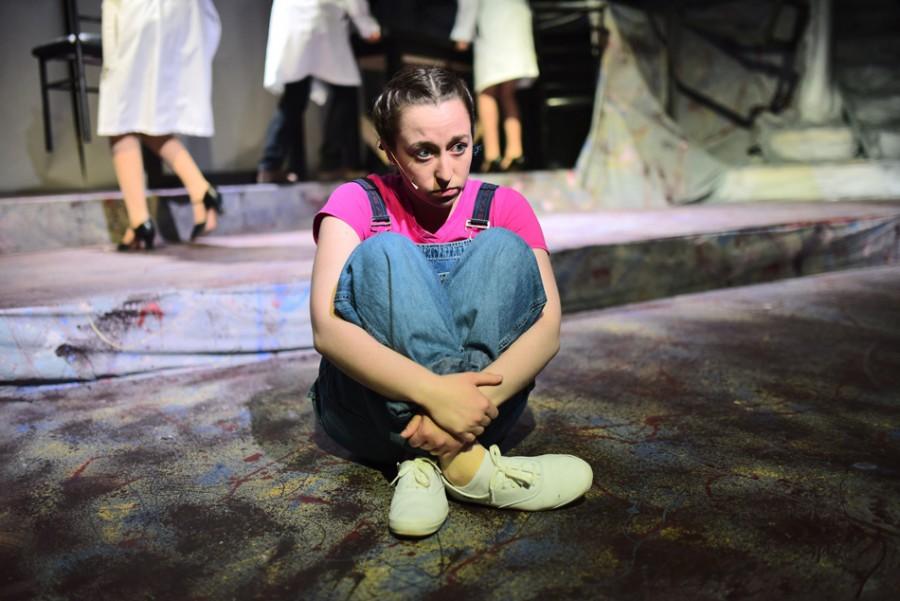Arts Alliance produces show based on ‘The Who’ album
Sophie Mann/The Daily Northwestern
Performers rehearse for “The Who’s Tommy,” which will be one of the largest theater productions in Student Theater Coalition history. The rock musical is based on the 1969 The Who album, “Tommy.”
May 14, 2015
A&E
Arts Alliance will debut one of the largest productions in Student Theater Coalition history with “The Who’s Tommy,” which opens Thursday for a three-day run at Norris University Center.
The rock musical, which is based on the 1969 The Who album, “Tommy,” is the Spring Quarter mainstage production for Arts Alliance. The group is also using the performance as an opportunity to make theater more accessible, with a special performance involving Northwestern’s American Sign Language Club.
In the original production, the main character, Tommy, is portrayed by three different actors who play the child, preadolescent and adult versions of Tommy. However, this “Tommy” will be different from most iterations of the 1992 musical, with the traditionally male role played by three female actors.
“It has really been fun to hear a lot of this music sung by different kinds of voices than we’re used to hearing this music being interpreted by,” said Maggie Monahan, a Communication sophomore, who will portray the adult version of Tommy.
Hannah Fisher, the director of the musical, said it was necessary to change the genders of multiple male characters to female, citing the large amount of female actors compared to male actors at NU.
“We had a lot of payoff on those risks, because they all sound really awesome,” the Communication senior said. “It’s a story that makes a lot of sense from the gender perspective as well.”
The production, which will include a seven-piece band, explores Tommy’s life after she witnesses her father shoot her mother’s lover in front of her. After the traumatic event, Tommy internalizes what she saw and chooses to not speak or be responsive to those around her.
“In the end, Tommy has to realize that the only person she can rely on is herself,” Monahan said.
For the NU production, two things separate “Tommy” from other shows: the size of the production and a special performance of the show involving the ASL Club.
The production will be one of the largest in StuCo history, producer Claire Huntington said. Monahan, Huntington and Fisher all agreed the set design was spectacular.
“Everything you see in that room is something that hasn’t really happened in StuCo before, in student theater,” Huntington said. “The projections are like no other. The set is bigger than most sets are. The stairs are the tallest in StuCo history. It’s a big show, and my designers have a lot to be proud of.”
The Friday showing at 7:30 p.m. will take place in Norris’ Louis Room and feature members of the ASL Club interpreting Tommy’s story for people who are hard of hearing.
“It’s going to be a really interesting and particularly poignant story for people who are experiencing life internally primarily, because that’s what Tommy has to do,” Monahan said. “I’m really excited to have a group of people who don’t usually get to experience theater this way have their voices recognized specifically in the room.”
The involvement of the ASL Club members is a part of Arts Alliance’s mission to make art accessible to a larger audience.
“Historically, lots of people have been shut out of artistic spaces for a variety of reasons,” said Talia Weingarten, co-chair of Arts Alliance. “We’re seeking to disrupt that pattern and really insist on the fact that art is not a luxury, it’s a necessity.”
In a similar vein, Arts Alliance will host an event titled “A Panel on Accessibility in the Arts,” on May 23, which will feature five theater professionals who have been committed to increasing accessibility in the arts and will be moderated by theater Prof. Michael Rohd.
“We’re hoping that we will get a diverse range of voices in a room and hash out simultaneously the breadth of what it means to be practicing accessible theater,” Weingarten said, “but also the specificity that’s required to do it well.”
Although Arts Alliance has tried in the past to make art more accessible by producing more well-known titles, Weingarten said the organization wasn’t addressing communities that traditionally aren’t able to enjoy art.
“We realized we were not doing anything around making those spaces welcoming to people with disabilities, people with lower-income statuses, things like that,” the Communication junior said. “We decided to start tackling specific facets of accessibility rather than going about it in a broader way.”
For Fisher, “Tommy” is a venture that she wouldn’t normally do. The director has mainly focused on smaller productions and plays, instead of musicals. However, she said she connected with the music in the show and wanted to challenge herself.
“The lovely thing about ‘Tommy’ is that it’s a rock musical, and the music is something I grew up with, like an album that my sisters played for me,” Fisher said.
Fisher said the show explores conformity, especially in Tommy’s character.
“The big takeaway is that you have to be faithful to yourself, even if yourself is something that changes over time,” she said.
Monahan, who has worked with Fisher in the past, said the role of Tommy is her “dream role for this season.”
“I’m just really excited to share this story with the campus,” Monahan said. “Tommy’s ready to fly.”
Email: [email protected]
Twitter: @benjamindin



